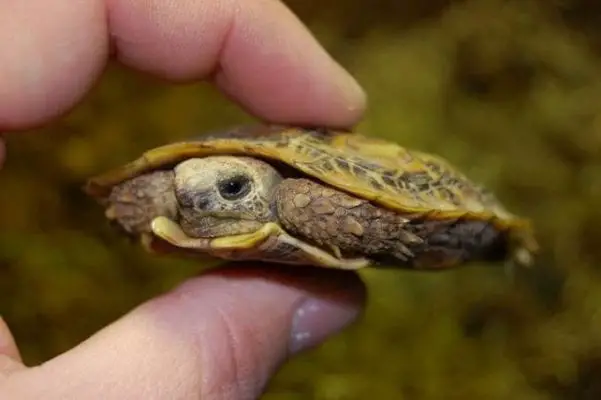Scientific Facts
| Common Name | Pancake Tortoise |
| Scientific Name | Malacochersus tornieri |
| Captive Lifespan | More than 20 Years |
| Size | 5. 90 – 7.08 inches |
| Mass | 1 pound |
| Habitat | Rocky hills and outcrops across arid scrub areas, dry savannas in the sub-tropical and tropical areas, and flat grasslands |
| Country of Origin | Kenya and Tanzania |
Physical Description
The Pancake tortoise is part of the family Testudinidae, genus Malacochersus. Other common names include African pancake tortoise, crevice tortoise, Tornier’s tortoise, and Softshell tortoise.
Both physically, as well as behaviorally, the Pancake tortoise is a unique species in the tortoise family.
Pancake tortoises are characterized by shells that are unusually flexible, flat, and nonetheless, thin, resembling a pancake, and hence their common name. Furthermore, the shell is very agile and lightweight, thanks to the many shell bones openings, contrary to what is typical for most other tortoises as they are characterized by solid structural shells instead.
The shell of Malacochersus tornieri is known to grow to about 7 inches in length, while the tail usually grows to about 1 inch.
Thanks to the brown carapace coloration, commonly with varying patterns on each shell plate, characterized by radiating dark lines, these tortoises are capable of camouflaging themselves perfectly in their natural habitat in the wild.
The head, limbs, and tail coloration are brown-yellow, while the bottom of the shell is colored in pale yellow, exhibiting seams in dark brown and rays in light yellow.
Types
The Pancake tortoise (Malacochersus tornieri) is the only, and in fact, the last living member of the genus Malacochersus.
Habitat & Lifespan
Distributed across the African continent, and in particular, in Sub-Saharan Africa, Pancake tortoises are endemic to eastern and northern Tanzania, as well as southern Kenya.
Having been successfully introduced to Zimbabwe, these tortoises are also known to occur in Zambia.
In the wild, these tortoises’ habitats include arid savanna and torn scrub located at 100 to 6000 feet above the sea level, where they can be found on kopjes, referring to hillsides characterized with rocky outcrops. In addition to that, pancake tortoises are known to occupy small hills of the crystalline basement in the low altitude dry savanna.
Inhabiting the floristic region of Somalia-Masai, pancake tortoise prefers the semi-desert habitat marked by Brachystegia woodland and Acacia-Commiphora bushland.
Pancake tortoise lives for over 20 years, and in fact, most do well for over 35 years.
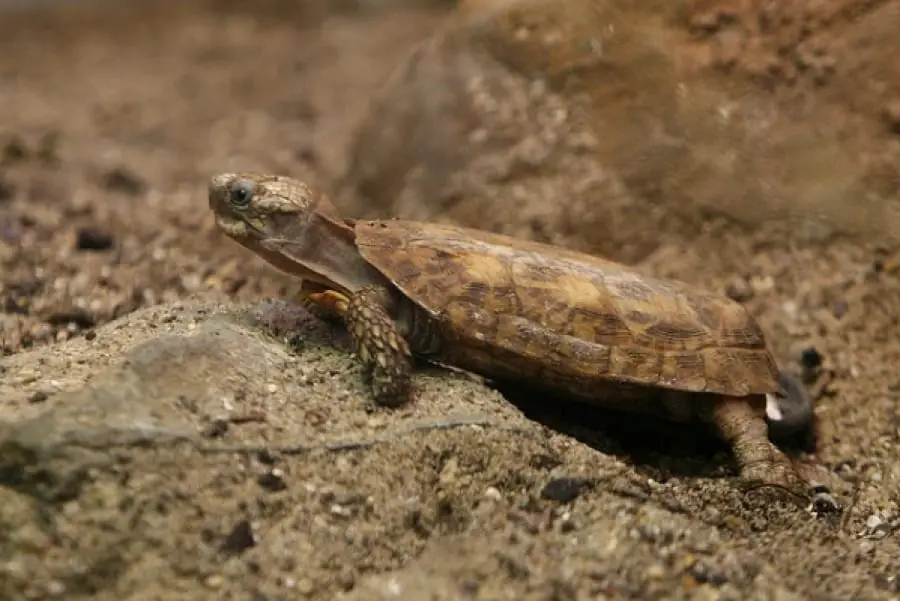
Behavior
The unique, unusual, curious behavior of Pancake tortoises makes them some of the most incredible tortoises across the globe. They are known to live in isolated colonies where many of them share the same hillside rocky outcrops, and in fact, sometimes they share the very same crevice.
During the mating season, males will fight for the females. The large males typically stand the highest chance to gain the attention of the female and to successfully mate in return.
Pancake tortoise can rarely (if ever) be found far away from their rocky homes. By doing so, these tortoises are capable of making a quick dash for the nearest crevice if threatened.
Instead of hiding inside their shells if disturbed, pancake tortoises make perfect use of their agile, fast climbing abilities, as well as their flexibility, to escape from just about any dangerous situation. They can be easily torn apart by potential predators if they are to simply withdraw into their shells.
It is the flexibility of the shell that allows Malacochersus tornieri species to quickly crawl into narrow rock crevices whenever they need to get away from potential predators. Thanks to their extraordinary shells, pancake tortoises can exploit an environment that no other tortoises in the world are capable of using.
Housing
1. As a rule of thumb, caregivers can successfully house pancake tortoises both indoors, as well as outdoors.
2. For indoor enclosures, the minimum space required for pancake tortoises to thrive is a 40-gallon terrarium. However, if possible, utilizing a larger terrarium is highly recommended.
3. For housing pancake tortoises outdoors, following strictly the enclosure design precautions listed below are strongly encouraged to help these amazing reptiles thrive healthy and happy for years to come.
4. For housing up to two adult pancake tortoises outdoors, the enclosure has to be at least 4ft. For every additional tortoise, one might want to cohabitate in the enclosure, add 2sq.ft. space for each of them.
5. The walls of outdoor enclosures should be at least 1ft. tall. However, full-grown adult pancake tortoises housed outdoors should better be provided with taller walls. Ultimately, the goal is to make sure that the tortoises will not be able to reach the top of the enclosure when they are to stand against the wall, using their hind legs.
6. Keeping in mind that pancake tortoises are excellent climbers, utilizing a screen top that fully covers the enclosure is also strongly recommended for outdoor enclosures. Otherwise, the tortoises are capable of scaling vertical walls whenever they feel like it.
7. When it comes to the furniture of outdoor vs. indoor enclosures, both should actually include quite the same items, with the exception that cage furniture for outdoor enclosures, including scalable items of all kinds, should be placed away from the walls.
8. Providing climbing, as well as hiding areas, is a must. For this purpose, caregivers can opt for realistic, natural-looking artificial rock hides that are widely available both online and offline.
9. Two hiding spots should be provided per 1 pancake tortoise. One of the hiding spots should be located on the cool side of the enclosure, while the other hiding spot should be located on the warm side of the enclosure.
10. In order to provide pancake tortoises suitable crevices to explore, carefully stack flat rocks in a suitable corner of the terrarium. Using slate stone to build tiered hides is rather easy, and it provides great multiple levels that equal multiple hides.
Important Note:
In some areas in the world where the climate is suitable, it is possible to house pancake tortoises outdoors throughout the spring, summer, and fall season. However, it is a must to house them indoors when the temperature falls below the optimal rates during the winter, since pancake tortoises do not hibernate.
Substrate
1. As a rule of thumb, the type of substrate utilized by the caregiver should allow pancake tortoises to dig, and therefore, it has to be loose enough.
2. Coconut bedding, bark, as well as rabbit pellets, will work great.
3. Potting soil also makes a wonderful substrate for pancake tortoise. A combination of sand, soil, and peat moss is the superior type of substrate.
Temperature, Lighting & Humidity
1. To maintain the temperature within the optimal range, pancake tortoises caregivers need to create a temperature gradient. The temperature gradient will allow the reptiles to thermo-regulate their body temperature as needed.
2. On the cooler side, keep temperatures from 70 to 75 degrees Fahrenheit. Also, provide a hotspot where the temperature reaches 100 and up to 108 degrees Fahrenheit. A ceramic heat emitter can work excellent for maintaining the desired temperature in the hotspot.
3. The ceramic emitter should be kept ON 24 hours a day.
4. Pancake tortoises’ lighting requirements are not at all fancy since even if they are housed in an indoor enclosure, these tortoises can be allowed to take short trips outside during the sunny hours of the day, as long as the caregiver does not forget to monitor them closely as to prevent them from escaping. However, utilizing suitable artificial light remains the best option for indoor terrariums, especially when taking into account that regular trips outdoors on a daily basis is certainly time- and effort-consuming task.
5. Pancake tortoises housed indoors require full-spectrum lights. Mercury vapor bulbs make a wonderful choice, and usually, a 125W bulb will do great, although it is good to know that Watt numbers tend to be different according to light bulbs brands, so make sure to check out these numbers carefully.
6. Place light bulbs at least 2ft. away from the surface of the substrate.
7. Another lighting option is a fluorescent UVB bulb. These lights should be spanning across the entire length of the enclosure.
8. Lights have to be kept ON 12 hours a day vs. switched OFF for 12 hours during the night. By doing so, caregivers will provide a suitable photoperiod for these reptiles to thrive in captivity.
9. Adult pancake tortoises do not require humidity, so daily misting the enclosure should not be executed.
Diet
Pancake tortoises are terrestrial grazing herbivores. In the wild, they majorly feast on different fresh and dry grasses; however, various other vegetation is also part of their diet.
When kept as pets, pancake tortoises’ diet routine should consist of fresh-cut grass, greens, and vegetables. As with other reptiles, a varied diet is key. It is good to know that these tortoises take certain fruit found in their natural habitat only occasionally.
Eating Habits
1. Pancake tortoises should be fed every day with a mix of spring greens, as well as grasses, such as hay, dandelion, turnip, mustard, and collard. Hibiscus leaves and other leafy greens and grasses can be provided, too.
2. Once or twice every week, feed the tortoises commercial-grade diet, such as Mazuri tortoise food, in a mix with natural grassland food, in order to supplement fresh food.
3. Fruit treats should be only provided once and up to twice a month, in a very moderate amount.
4. Once or twice a week, dust fresh food items with high-quality calcium powder, and don’t forget about multivitamins, too.
5. Additionally, to dusting food with calcium, caregivers can also provide another suitable source of calcium that can be available for the tortoises to munch on whenever they choose to: adequately sanitized eggshells. Note that these tortoises are far more likely to eat eggshells, rather than cuttlefish bones, because of eggshells being encountered in the wild, unlike cuttlefish bones.
6. Other fresh food items that pancake tortoises enjoy include endive, carrots, and squash, among others.
Sleeping Habits
Pancake tortoises do not really hibernate in the wild. However, there are existing reports that these reptiles actually sometimes aestivate (aestivation is a process similar to hibernation in the sense that the animals are to fall asleep to regulate their body temperature) during the hot summer months, hidden beneath flat rocks.
Both captive, as well as wild pancake tortoises, can aestivate as needed.
Pancake tortoises are diurnal creatures. The peak of their activity is known to occur in the early evening, late afternoon, or in the morning hours, when the tortoises come out in order to feed and bask, becoming quite mobile and curious to observe.
Interestingly, pancake tortoises do typically emerge from their shelter for only about one single hour at a time.
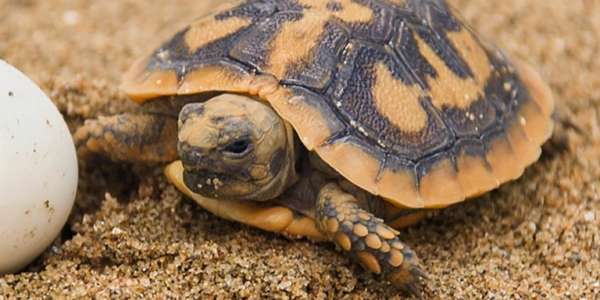
Water
Pancake tortoises raised in captivity must be provided with a shallow water bowl, filled with clean, fresh water at all times. The water bowl should be large enough to allow the tortoise to comfortably soak whenever desired.
Keep the water bowl away from the food bowl. By doing so, you will be able to lower the cases of tortoises defecating in their water bowl after taking their food.
However, even when the water bowl is placed away from the food bowl, caregivers need to keep in mind that pancake tortoises will inevitably poop in their water quite frequently, as they adore to do so as much as they adore soaking. Because of this, you want to be prepared for cleaning the water bowl several times a day.
Development and Reproduction
Up-to-date, there is still too little data available when it comes to the mating system of pancake tortoises in the wild.
Experts have managed to learn that this species may exhibit varying mating behavior. Pancake tortoises can be polygynandrous (aka promiscuous), meaning that both females and males alike can have multiple mating partners, or they can be polygynous, with only one single male being “in charge” of mating with many females.
The competition between males trying to access a female to mate with is very strong in the wild, with larger male tortoises gaining more success than smaller ones.
In their natural habitat in the wild, the breeding season is known to occur throughout January – February. However, for captive pancake tortoises, whether it be those kept as pets or those raised in zoos, breeding can take place all year-round.
Nesting takes place from July and up until August in the wild. The female is to build a nest cavity in loose sandy soil, and then she is to lay an egg that is approximately 2 inches in length.
Females only lay one single egg at a time. One and up to two months later, they may lay egg another egg, and in some cases, this can be repeated once again after another 4 – 8 weeks. Eggs incubate at temperatures within the 86 degrees Fahrenheit range.
With captive pancake tortoises, the incubation period lasts for four and up to six months. Hatchling is really tiny, about 1 – 2 inches. On hatching, they are 100% independent, and no further parental care is provided by neither the adult females nor the males.
How to Breed
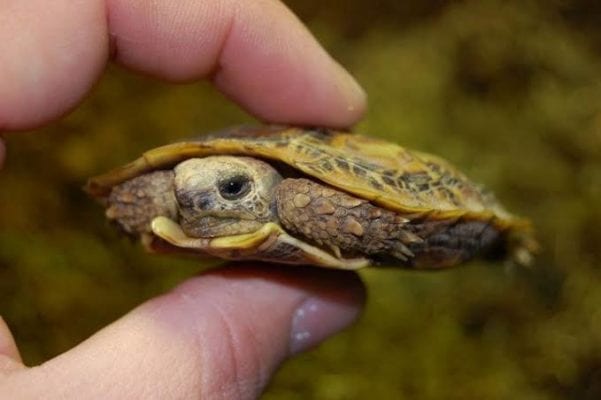
1. To breed pancake tortoises in captivity, the first rule of thumb is that the ratio of adults should be 1 male to 2 females.
2. Pancake tortoises that have reached 3 inches in size can be sexed easily and successfully.
3. To tell a male pancake tortoise from a female, take a look at the tail. Females’ tails are visibly shorter and skinnier, as compared to those of males. Also, a big star cloacal opening takes up most of the female’s tail.
4. Make sure to provide a soil spot, so that the female can lay her eggs. Females usually prefer laying eggs underneath stones located right next to the soiled spot.
5. Remove the egg from the soiled spot in an about a few hours after it has been laid. Next, place the egg facing the exact same way up, just like you found it.
6. Sometimes, pancake tortoises can lay their eggs vertically. If this is the case, just wait for a few hours after the egg has been laid, and move it away, minimizing jostling as much as feasible.
7. To hatch the eggs, you can place them on the soil where they have been laid. Vermiculite also makes a wonderful option.
8. Being temperature sex-dependent, you can hatch female pancake tortoises provided you incubate the eggs at 82 – 92 degrees Fahrenheit. To hatch male pancake tortoises, incubate the eggs at 84 – 77 degrees Fahrenheit. To produce a mixed batch with both males and females, incubate the eggs at 85 – 86 degrees Fahrenheit.
9. To incubate the eggs of pancake tortoises properly, you can go with humidity levels as high as 80% or as low as 0%, since their eggs do not have any complex humidity requirements.
10. It can take anything from 90 to 280 days for the eggs to incubate, so be patient. Hopefully, with a little bit of luck, the eggs will be fertile, and you will be able to enjoy the tiny, adorable baby pancake tortoise to the fullest.
11. When the babies hatch, transfer them into a separate container. Line the bottom of the container with a moist paper towel, and keep it well-moist for full 24 hours, as to allow the babies to fully absorb the yolk, and the shell to flatten.
Hatchling and Juvenile Care
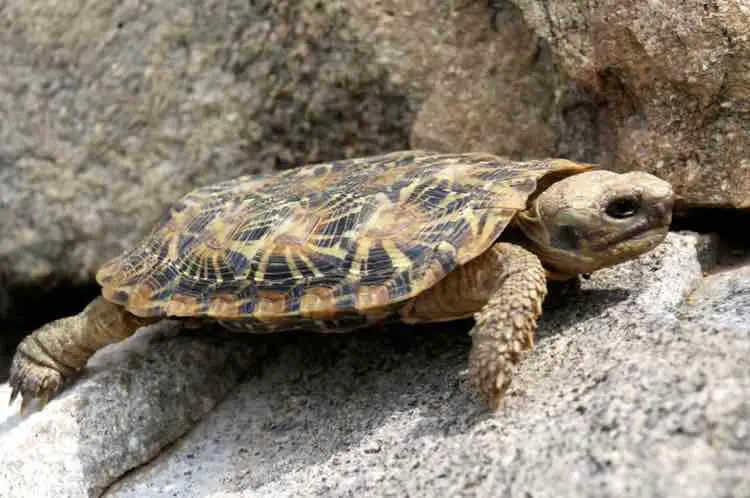
Lighting
Similarly to adults, hatchlings and juveniles can be taken outside on regular “trips” as to bathe insufficient sunlight, as long as you make sure to monitor them. Using full-spectrum lights in the same way as adults will work excellent, with the only exception that unlike as with adults, lights must be placed 2ft. away from the surface of the substrate.
Humidity
To help promote the healthy growth of their shells, young pancake tortoises require humidity, just like all other baby tortoises do. Maintain humidity at about 50% – 60% throughout the day, increasing it to 80% throughout the night.
Keep juveniles exposed to the humidity levels listed above until they reach about 4 – 5 inches in length. At this point, you want to slowly start lowering the humidity.
To help keep the humidity up, you can make fantastic use of moss. Just place moss in the hides, as well as around the enclosure.
Temperature
Hatchlings will thrive at the same ambient temperatures as adults. Just do not let temperatures fall below 68 degrees Fahrenheit, as this can lead to hatchlings falling victims to respiratory infections due to the combination of high humidity and lower temperature than the recommended healthy rates.
Food and Water
Feeding juveniles and hatchlings are exactly the same as with adults. Provide a suitably-sized water bowl that is deep enough (yet not too deep) for a hatchling/juvenile to soak in as needed.
Substrate
Babies require a substrate that is able to retain moisture well. For this purpose, a combination of peat moss, topsoil, and just a little bit of sand will work great.
To help them get around, cover the majority of the soil with slate stone, making it slightly uneven, as to allow them to climb and explore.
The stone layer will allow the young pancake tortoises to develop healthy by preventing weak leg muscles and/or walking wrong on their immature feet. Also, the stone layer will help to prevent water from evaporating from the substrate too quickly, thus, contributing to the maintenance of proper humidity levels for an extended period of time.
Cleaning services
For bioactive enclosures, you will only have to change the soil every 8 months or so. For non-bioactive enclosures, changing the soil every 5 months should work just fine, as long as spot cleaning of poop and wasted food is maintained on a regular basis.
Hides
In order to help hatchlings feel as comfortable as feasible, you want to provide plenty of hides. Layered slate stone will allow them to climb on and in, ensuring healthy muscle development, while also assisting in nails wearing down as to prevent possible overgrowing. The hides should be big enough so that 2 and up to 3 babies can fit inside, but if only one baby is present, the hides can be made smaller.
Important Notes:
For hatchlings, outdoor enclosures are not the best choice in general, and that’s major because maintaining proper humidity levels outside is much more difficult to achieve than doing so indoors. Adequate humidity levels are crucial for hatchlings, as it is thanks to high humidity how their shells grow well and smooth. Also, hatchlings may be exposed to various unwanted intruders that can cause them harm, such as ants.
Juveniles can do significantly better outdoors, yet it is highly recommendable to bring them out during the day, and then bring them back in during the night.
Handling
To handle a pancake tortoise, make sure to fully support its body. Do never grab it by the limbs, tail, or head, but instead, gently lift it by placing your hands from below. With baby pancake tortoises, you can use your fingertips to lift them (and why not take a cute pic or two).
Do not squeeze or otherwise force the animal, and make sure not to drop it on the ground, as to limit any possible injuries and stress. Be careful and respectful.
Handling pancake tortoises is not associated with any serious negative effects on the animal’s health and well-being. However, considering that these reptiles are not naturally used to being handled, it is best to limit such type of interaction in favor of other ways you can entertain and spend quality time with your pancake tortoise pet.
How to Treat and Prevent Possible Health Issues
1. Ultimately, Malacochersus tornieri species is known as a really hardy one. With this in mind, neither diseases nor possible parasite overloads, are common with most pancake tortoises, as long as they are provided proper care. However, if the caregiver has any suspicion that his/her pancake tortoise pet may be sick, please, do not hesitate to consult with a qualified reptile vet as soon as possible, since any issues will be much easier to treat successfully when caught in a timely manner.
2. Remember that these species are naturally great at climbing, so it is fair to state that climbing is in their blood. When arranging slate stone as part of the enclosure furniture, make sure it is uneven, so that the tortoises’ climbing needs will be satisfied. By doing so, caregivers will further ensure that the reptile pets are given the opportunity to exercise properly, as to avoid weak leg muscles, and/or walking on their feet incorrectly.
3. Do not allow ambient temperatures to fall below 64 degrees Fahrenheit, or else, encountering health problems is inevitable.
Possible Dangers to Humans
Pancake tortoises are not aggressive animals, and they are also not capable of inflicting a dangerous bite. In general, these tortoises pose little to no serious threats to humans.
However, similarly to other reptiles, pancake tortoises may carry Salmonella bacteria. Although very rarely, Salmonella can be transferred to humans by possibly being ingested after direct contact with the reptile and/or its feces, in the case the caregiver has not washed his/her hands thoroughly after the interaction.
Availability: How to Get a Pancake Tortoise?
Not that long ago, pancake tortoises in the wild used to be collected for pet trade without any legal regulation of their populations. And so, due to their high demand in the pet trade, numerous wild-caught pancake tortoises were exported to various parts of Europe, as well as the United States, up until the point when export practices actually started to seriously threaten wild populations.
Fortunately, up-to-date, very few exports occur, and any of these exports are strictly regulated, making the pancake tortoises supply drop while their price has rapidly increased in return.
For those who wish to get a pancake tortoise to keep as a pet, opting for captive-bred tortoises is the right way to go. Sometimes, it might be difficult to find these amazing reptiles available by reputable vendors, especially since their production in captivity is rather low as pancake tortoises only lay a single one and a maximum of five eggs every year.
Most importantly, by making the conscious buying decision to purchase nothing but captive-bred Malacochersus tornieri, we can help to further support captive breeding practices by making more people breed them, thanks to high demand so that ultimately, we can preserve wild populations for generations to come.
Fun Facts
1. Because of their pliable plastron, pancake tortoises used to be called “softshell tortoises” for quite sometime before the common name “pancake tortoise” became more popular. Also, previously, these amazing reptiles were thought to be able to inflate themselves and to then wedge their bodies into their favorite rocky cracks, much like chuckwalla lizards.
2. Thanks to their extraordinarily flat, flexible, and thin shell, pancake tortoises are the fastest of all tortoise species on the planet, capable of reaching 8 km/h at their top speed!
3. Like all other tortoises, pancake tortoises do also have domed shells upon hatching. Later on, as they grow, though, their shells are to flatten, living up true to the common name of this tortoise species.
4. Contrary to other tortoises, pancake tortoises do not hide but run when they are scared and are therefore commonly called “hiders,” as well as “sprinters.”
5. By planting their spiky legs tightly and solidly into the space of rocky crevices, it is almost impossible to dislodge pancake tortoises shortly after they have burrowed themselves.
6. If pancake tortoises are to fall on their backs, they can flip upright much more quickly than other tortoises, thanks to their shells being significantly more lightweight.
How to Take Care of a Pancake Tortoise
1. Pancake tortoises are known to perform great when living in a group with other Malacochersus tornieri. Even though these reptiles are naturally solitary creatures, they can be cohabitated together, as long as the caregiver remembers to always pay attention to the individual behavior of each tortoise, and especially when it comes to adding new members to the group, since some might not get along very well at the beginning.
Usually, if enough hides per tortoise are provided, and if there aren’t more males than females in the group, any fights between individual animals can be prevented from ever happening.
2. If birds of prey are an issue, depending on the caregiver’s area of residence, a screen-top made by using hardwire cloth should be used to protect pancake tortoises housed outdoors from harm. If birds of prey are not an issue, though, the keeper can have an open-top outdoor enclosure, as long as it is tall enough to prevent the tortoises from escaping by using their fantastic climbing skills.
For those who live in the south where carpenter bees tend to be numerous, painting the enclosure blue can help to keep them away.
3. If potting soil is used as a substrate, the caregiver must be 100% sure that the soil does not contain any toxic chemicals or potentially harmful microorganisms, such as pesticides, fertilizers, and/or animal manure, in order to prevent possible health issues.
4. One of the ways to make a bioactive enclosure is to keep pill bugs in there, so that you will only have to spot clean the cage as needed without having to change the substrate out at all, except for every once a year or so.
FAQ Section
Are Pancake Tortoises Endangered?
As seen on the IUCN Red List, the populations of pancake tortoises in the wild are classified as critically endangered. Pancake tortoises are protected from the illegal pet trade, thanks to being listed on Appendix II of the CITES (Convention on International Trade in Endangered Species of Wild Fauna and Flora).
Are Pancake Tortoises Good Pets?
Yes, pancake tortoises make fantastic pets, as long as the potential keeper takes the time to consider the long-term commitment associated with taking proper care of these friendly, curious, wonderful living creatures. Only buy captive-bred animals, making sure to ask for a guarantee of the captive-bred origin of the reptile, as not to contribute to the illegal over-collection of wild pancake tortoises that puts these amazing reptiles at risk of becoming extinct.
Where Do Pancake Tortoises Live?
In the wild, the preferred type of habitat for pancake tortoises is rocky outcrops, also known as kojpe habitat, and these reptiles are endemic to East Africa’s arid scrublands and savannas. Found to live in unique isolated colonies, pancake tortoises are native to northern and eastern Tanzania, as well as southern Kenya.
Do Pancake Tortoises Hibernate?
No, pancake tortoises do not hibernate, and because of this, they need to be housed indoors during the cold winter months. Even though they do not hibernate, they are known to sometimes aestivate during the hot summer months.
Where Do Pancake Tortoises Hide?
Since pancake tortoises inhabit rocky outcrops (aka kjopes), it is in the rocky crevices where their tortoises are known to hide. When they feel threatened, they will run away surprisingly quickly instead of withdrawing into their flat, pancake-like shells, planting their legs so tightly between the rocks, that it is almost impossible to pull them out.
How Many Eggs Does a Pancake Tortoise Lay?
Even though pancake tortoises may lay multiple clutches per year, they will only lay one single egg every four to eight weeks, and they may lay another one in the course of the following four to eight weeks. The eggs are characterized by a hard, white shell, measuring about 1 inch in width and 2 inches in length.
Can Pancake Tortoises Eat Pancakes?
Even though pancake tortoises, as well as other tortoise species alike, may eat pancakes if provided such, as shown in funny pictures of tiny tortoises eating tiny pancakes that went viral, the tortoises’ proper growth and well-being can be seriously hindered by feeding them with pancakes. Pancake tortoises live up true to their common name because of their flat, pancake-like shell, but they must not be fed with pancakes due to various nutritional reasons.
Do Pancake Tortoises Enjoy Being Touched?
Yes, pancake tortoises, like other tortoises, do enjoy being touched, especially when it comes to petting and lightly scratching their necks. Tortoises can feel when their shells are touched, too, due to their shells having nerve endings, although sometimes, they may or may not enjoy being touched accordingly.
How Do I Know My Pancake Tortoise Is Healthy and Happy?
You can tell that a pancake tortoise is healthy and happy, provided the reptile is able to move about fairly quickly when active during the day. The top of the shell should feel firm and smooth to the touch, with no obvious bumps or any other signs of injuries, and the eyes should look clear.
Do Pancake Tortoises Recognize their Owner?
Yes, pancake tortoises can learn to recognize their owners, readily showing their friendly attitude in the presence of their dedicated, favorite caregivers. Similarly to other tortoise species, pancake tortoises are quite affectionate creatures, even though they cannot show love to their owners in the same sense as cats and dogs.
Are Pancake Tortoises Smart?
Most terrestrial tortoises are much smarter than what most people think they are. In fact, as pancake tortoises can learn to respond to their names, as well as possibly displaying inclination to following their caregiver around, they are considered a sort of reptilian prodigy.
What Should I Feed My Pancake Tortoise?
About 80% of a pancake tortoise pet’s feeding routine should consist of fresh leafy greens and grasses, like collard greens, and dandelions, among others. Feeding pancake tortoises commercial-grade tortoise diet should make up for about 20% of their feeding regime, along with a very moderate amount of veggies and/or fruits, such as squash, carrots, melon, apples, and grapes, offered only as treats.

